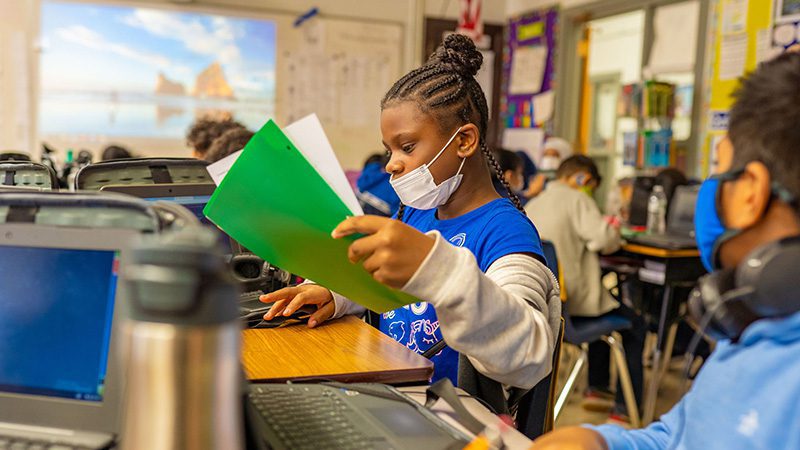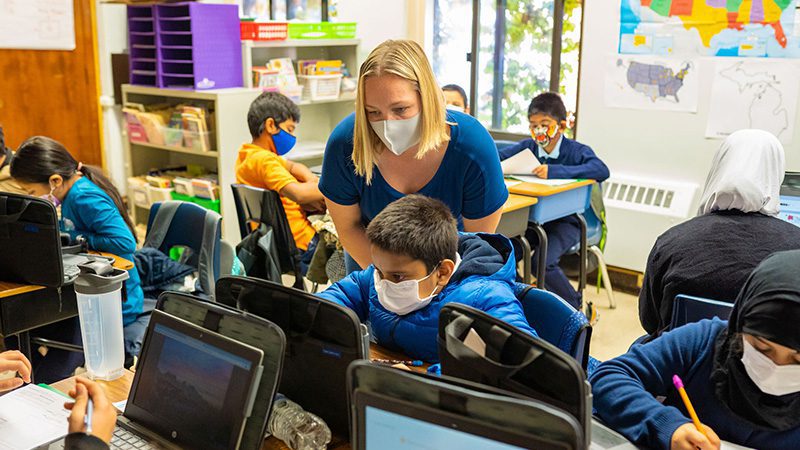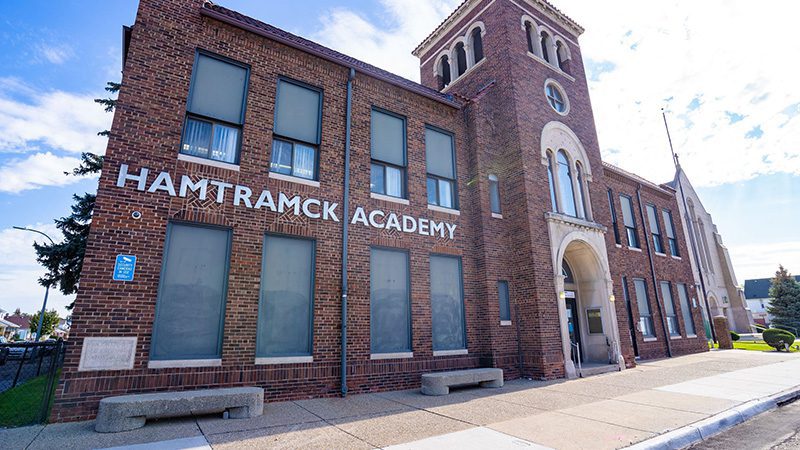Hamtramck Academy
Embracing Culture and Heritage with a Laser-like Focus on Data and Individualized Learning
By Courtney Wise-Randolph
Inside Hamtramck Academy, a K-8 public charter school, the school’s students, staff and families are united in a common goal to help students achieve. Families, many of whom are recent immigrants, share a fervent hunger for learning and achievement – a passion that the school principal embraces.
“We feed on that hunger,” said Dr. Alvin Ward, the school’s principal. By providing great structure in a safe, fun environment, along with all of the teaching and direct support resources students need, Hamtramck Academy is perfecting a recipe for every student’s success. “We do what we should do for kids that need us,” Ward says, matter-of-factly.
Every available foot of the small, densely-populated building is used for instruction, including the hallways. Many of the students are multi-lingual and come from low-income households, which can be considered a barrier for students. And yet as of 2019 at Hamtramck Academy, the majority of students were proficient in math and nearly half were proficient in reading. “We dispelled the myth that students from humble beginnings can’t be successful,” Ward said.
Embracing data and honoring culture so all students succeed
Part of the instructional strategy of Hamtramck Academy is to use student data on an ongoing basis to track progress and inform individualized instruction. Teachers pay special attention to the differences between state assessment performance and day-to-day performance to determine needs for further intervention and focused, small group instruction.
Teachers at Hamtramck Academy also receive training on the best strategies to increase students’ vocabularies from the school’s English learner coordinator. During the training, teachers review student assessments as a first step in individualizing instruction. They then get specific training on how to support students at varying levels, along with an introduction to teaching resources and websites that can support their direct instruction to students in real time.
At the same time, the school takes special care to embrace the cultural diversity of the school and use culturally- and linguistically-responsive practices to reflect the racial and ethnic diversity beyond the school’s walls in the heart of the city of Hamtramck.
Historically a Polish enclave, Hamtramck’s immigrant communities have grown over the last few decades, with many residents hailing from Bangladesh and Yemen, as well as Poland. The city is also home to a fast-growing Muslim population where residents elected the first majority-Muslim city council in 2015.
A large number of our families may need to have [additional] support, so we have to be that anchor in the community. And we have that reputation, as a community,” said Ward. “That’s why our wait list stays the way it is, because parents know what we turn out, how we’re dedicated, and how we feel about our students.”
Principal

There are significant cultural differences between school leadership, the school’s teachers, and Hamtramck Academy’s families. Many of the households represented are Muslim and southeast Asian, while the school’s leadership team and much of its teaching staff are comprised of Black and White educators, born and raised in southeast Michigan, who whether they practice religion or not, adhere to Judeo-Christian customs.
A significant factor in the culture of the school – and a factor in its formula for success — is that Hamtramck Academy faculty and staff demonstrate a commitment to engaging families and honoring the many cultures represented in their school community.
For instance, they provide Arabic and Bengali translators, offer diverse reading materials, and use culturally-responsive communication.
“Each year we’ll do multicultural day, and we’ll have [other] multicultural events that encourage others to learn about where the population of most of our students are from,” said teacher Andreell Harris. “We also focus more on teaching the students to respect each other and about how everyone is different because [Hamtramck Academy] is a big melting pot of students.”
K-2 interventionist Karah Yancey also invites students to teach her their language and culture. “I will ask them, ‘Will you help me learn a few words?’ And they think it’s great, because I’m like, ‘No really, I want to try to say it—and, if I say it wrong, you have to correct me.’” Yancey uses what the students teach her to form stronger bonds with them and other students.
It takes a village
The team at Hamtramck Academy also honors the notion that ‘it takes a village’ to foster strong progress and growth for their students.
“A large number of our families may need to have [additional] support, so we have to be that anchor in the community. And we have that reputation, as a community,” said Ward. “That’s why our wait list stays the way it is, because parents know what we turn out, how we’re dedicated, and how we feel about our students.”
For instance, students at Hamtramck Academy receive support of a multi-faceted community – strong school leaders, skilled teachers, multilingual paraprofessionals and family liaisons, as well as academic interventionists, and parents all working together to ensure students achieve.
Students also work closely with each other to help one another grow academically. Teachers pair newer students with student veterans to help them acclimate to learning in a new language. Assessments are frequently taken to keep an accurate record of what students have learned and what they still need to know, and data is used to tailor instruction to each student.
To ensure students get the attention they need in grade-level instruction, additional fully certified teachers “push-in” to classrooms to support students during math and reading instructional blocks. This is in addition to the small group intervention students receive to accelerate their individual growth.


Alongside the intensive instructional support provided to students, Hamtramck’s staff makes sure to vary students’ intervention groups to reduce stigma and promote an inclusive class environment.
For instance, Hamtramck Academy’s interventionist model is unique in that veteran teachers—some who spent a decade or more in the classroom—now work specifically to accelerate the progress of individual students and small groups who are behind. This is in contrast to schools that have paraprofessionals, rather than fully certified teachers, in intervention roles.
“We take [students] during their actual scheduled intervention time, when the teacher is not doing whole group instruction. Planning our schedule is something that we have to be really intentional about so that students aren’t losing any new instruction [by] coming,” Yancey said.
Just as importantly, the school’s deans and principal provide teachers with the autonomy to use their teaching and research expertise to “fill in the gaps” of the curriculum or adjust the order in which things are taught to be most effective for students.
For instance, before it became a model adopted by the school, fourth grade teacher Liz Mooneyhan began to implement the “You Do, We Do, I Do” instructional model in math. It is a newer research-based strategy that departs from the well-known “I Do, We Do, You Do” model. With the new model, students engage in “productive struggle” to take greater ownership of their learning.
“They actually learn more as they talk about math, struggle through math, and work with their partner or table,” said Mooneyhan. “I ask them to solve 25 times 15. They don’t know how to do that. But it’s amazing, when they work together, what they can figure out and talk through.”
This is just one example of the work that Hamtramck Academy engages in to ensure learning is tailored and each child’s needs are identified and addressed. When used schoolwide, Ward says, this individualized, tailored instruction is one of the keys to the school’s success.
“The only way that you can effectively help a kid is to know what their needs are. That’s simply where we start,” said Ward. “We start from the very basics of what they need, and then whatever they need [we do that] … When we say individualized, we really mean it.”